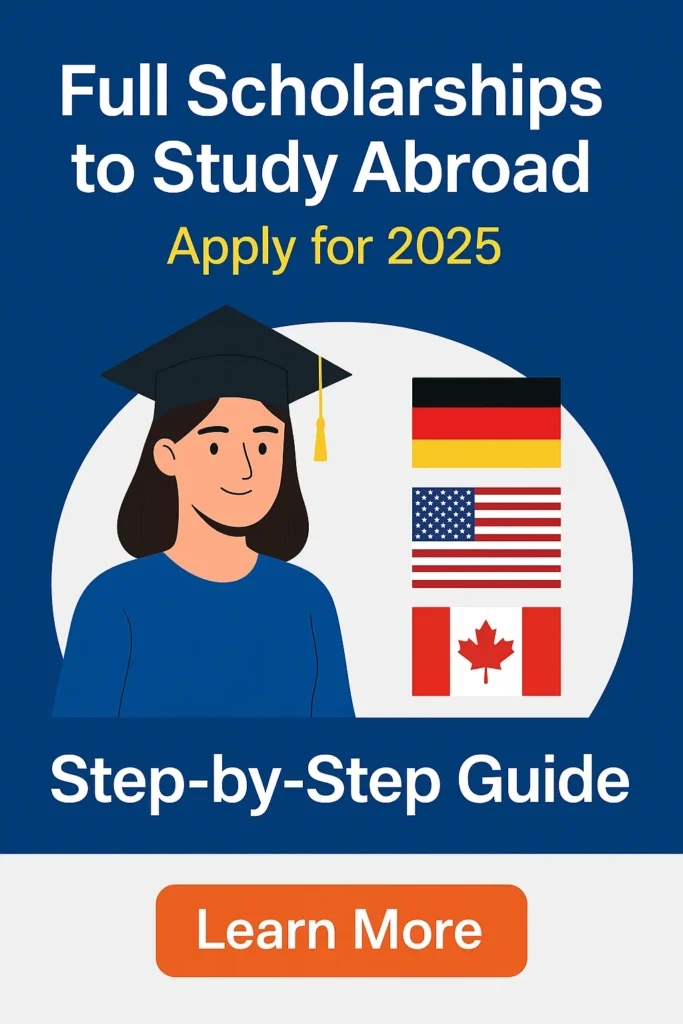Studying abroad can be expensive, especially when you include tuition, accommodation, travel, and other costs. But with the right knowledge and preparation, you can study abroad for free or very low cost by applying for full scholarships. In this article, you’ll learn exactly how to find, apply, and win scholarships for countries like Germany, France, Sweden, Canada, USA, and more — even if you’re from India, Nigeria, Philippines, Pakistan, or any other developing country.

What Is a Full Scholarship?
A full scholarship is a financial award that covers most or all of your major expenses, such as:
- Tuition fees
- Living costs
- Health insurance
- Flight tickets (sometimes)
- Study materials
Some are fully funded by universities, governments, or international organizations, while others are partially funded.
Types of Scholarships You Can Apply For
| Type | Covers What? | Who Provides It? |
|---|---|---|
| Government Scholarships | Tuition + living + travel | Governments (e.g., DAAD, Eiffel) |
| University Scholarships | Tuition fee + part of living costs | Specific universities |
| NGO or Private Grants | Partial or full support | NGOs, foundations, etc. |
| Merit-Based | Based on grades, exams, or talents | Governments or universities |
| Need-Based | Based on family income | Mostly universities |
Countries Offering Full Scholarships to International Students
Germany
- DAAD Scholarship: For master’s programs. Covers full tuition, monthly stipend (€934), health insurance, and travel allowance.
- Erasmus+: EU-funded program that covers tuition, monthly allowance, and travel costs for students studying in multiple European countries.
France
- Eiffel Excellence Scholarship: Covers full tuition, €1,181–1,700/month stipend, international travel, insurance.
- Campus France Scholarships: Many French universities offer their own grants through Campus France.
Sweden
- Swedish Institute Scholarship (SISGP): Covers full tuition, SEK 11,000/month stipend, and travel.
- University Scholarships: e.g., Lund University, Uppsala University, KTH Royal Institute of Technology.
Canada
- Vanier Canada Graduate Scholarships: For PhD students. Offers CAD 50,000/year for three years.
- Lester B. Pearson Scholarship (UofT): Full tuition + living expenses for undergraduate students.
USA
- Fulbright Program: Full scholarships for master’s and PhD students from over 160 countries.
- Clark University Global Scholars Program: Covers full or partial tuition for undergraduate international students.
Step-by-Step Guide to Applying for a Scholarship
Step 1: Start Researching Early
Start at least 8–12 months before your target intake (e.g., if applying for Fall 2025, start by August 2024). Use official websites only.
Where to search:
- https://www.scholarshipsads.com
- https://www.daad.de
- https://www.campusfrance.org
- https://studyinsweden.se
- https://educationusa.state.gov
Step 2: Choose the Right Scholarship
Filter by:
- Country
- Course/subject
- Level (undergraduate, master’s, PhD)
- Eligibility (age, nationality, GPA)
Shortlist 3–5 scholarships that match your background.
Step 3: Check the Requirements
Common requirements include:
- Valid passport
- Good academic performance (at least 60–75% or GPA 2.5+)
- English proficiency (IELTS/TOEFL or MOI)
- Statement of Purpose (SOP) or Motivation Letter
- Recommendation Letters
- Updated CV
- Proof of income (for need-based)
- Application form (online or downloadable)
Step 4: Write a Strong Motivation Letter (SOP)
This is the most important part of your application. Your SOP should include:
- Who you are and your background
- Why you want to study that subject
- Why you chose that country/university
- How the scholarship will help you
- Your goals after graduation
Tips:
- Be honest and focused
- Use simple language
- Avoid copy-pasting templates
- Stay within the word limit (usually 500–1000 words)
Step 5: Submit Your Application
- Create an account on the official scholarship portal
- Fill out the form carefully
- Upload all documents in the right format (PDF, JPG)
- Double-check spelling and grammar
- Submit before the deadline
Tip: Some scholarships close 9–10 months before the course starts. Never wait till the last week.
Bonus: Scholarships That Don’t Require IELTS
Some programs accept a Medium of Instruction (MOI) letter or conduct interviews instead of requiring IELTS or TOEFL.
| Scholarship / University | IELTS Required? | Alternative |
|---|---|---|
| DAAD (Germany) | Sometimes waived | MOI or interview |
| Uppsala University (Sweden) | Yes | Few exemptions |
| Eiffel Scholarship (France) | No | Based on SOP + CV |
| Erasmus Mundus | Depends on program | MOI sometimes accepted |
| Clark University (USA) | Optional | Duolingo accepted |
Common Mistakes to Avoid
- Waiting too long to apply
- Submitting incomplete or incorrect documents
- Weak motivation letter
- Using fake documents or false information
- Ignoring deadlines
Final Tips to Improve Your Chances
- Apply to more than one scholarship
- Keep your documents ready and organized
- Maintain a good academic record
- Prepare for interviews if required
- Practice writing SOPs in advance
- Stay updated on new scholarship announcements
Conclusion
Getting a full scholarship to study abroad is 100% possible — even if you’re from a middle-class background. It takes preparation, research, and effort, but the rewards are life-changing. Thousands of students from Asia and Africa get these opportunities every year, and so can you.
Start today by searching for scholarships, preparing your documents, and writing a strong application.